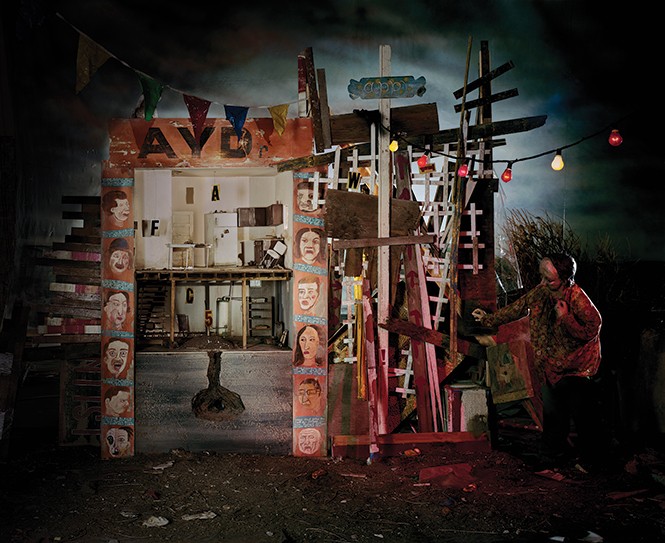A Sense of Place
Alice Gallery showcases works exploring the Architecture of Place.
By Brian Staker @stakerizedUtah as we know it today was constructed out of the aspirations of the early settlers to the area, without anything to support the notion that they could successfully build cities in a desert, except the visions in their heads. As with every place on earth, the state has its own architecture, which becomes both a reflection of the people who live here, and a force that shapes the way they live their lives.
Local artists have often created depictions of architecture, perhaps as a way of contemplating its effects. The state of Utah's permanent art collection includes many of these depictions, and Architecture of Place assembles 20 of these works at Alice Gallery for a survey of the subject. And while it only features 20 pieces from a collection of over 1,400, it's nevertheless a remarkable distillation.
The curator of the exhibit, Felicia Baca of the Utah Division of Arts & Museums, says of the show's subject matter, "It was a theme that emerged on its own from being familiar with the collection. ... I was looking at work that displayed some kind of architectural structures throughout time, in different sorts of landscapes, like LeConte Stewart's 'Cabin in the Hills' [oil on canvas, undated]." The cabin in Stewart's painting is a prime example of a Utah rural structure of the mid-20th century.
Carlos Anderson's "Deseret Store & Tithing Office" (pencil, 1934), the oldest work in the show, also evokes a specific cultural place and time, and resonates deeply with the state's history. Works in the exhibit aren't all representations of local scenes, however. Moishe Smith's "Jerusalem: Outside the Wall" (intaglio/etching, 1990) is a striking tableau of the Israeli capital.
In addition to works from the state's fine arts and public arts collection, two pieces in the exhibit represent folk art: a retablo by Jeronimo Lozano titled "House of the Red Tile Roof" (2003) representing laborers, and a papercut by Ada Rigby of the Salt Lake Temple, "Papercut of Life Story" (1990), which includes the religious edifice and pioneer scenes.
Although only a few of the featured works actually depict people, the buildings imply inhabitance. Works by Joey Behrens, Daniel Everett, Andrea Jensen, Bonnie Schenkenberg and Justin Wheatley depict sites that are indeterminate, where the "there" isn't there, and in the view of contemporary artists, architecture seems to be becoming homogenous. Ada Irvine's silkscreen/serigraph "City" (undated) is a composition that's barely recognizable as architecture, stylized plateau-like shapes that create the sense of a city by their overlay of colors.
But then David Brothers' "Aydr" (digital photo, 2016)—the most recent addition to the state's collection, part of the documentation of his installation "Rolithica" earlier this year at the Utah Museum of Contemporary Art—is a depiction of a site that appears completely fictional, populated with puppets. Brothers describes his piece as "something akin to an informational kiosk at the mall, or possibly a display or diorama to explain, at the visitors' center, what you're going to see. The nature of the place would be antiseptic, matter-of-fact and dumbed-down."
Baca says of "Aydr," "This place isn't a real locale, but the place is rather an emotional one that seems precarious, degrading, familiar and strange, all at the same time. This one in particular speaks to the ways architecture comes to resemble social or cultural relationships."
The exhibit also examines newer uses of structures. "Daniel Everett's works [Antenna I and II] show us that the architectural space is transcended by way of the structure. The antenna and what would appear to be satellite dishes likely communicate with other structures in other places." Troy Wenzel's "The Guard Tower" (mixed media, undated) reflects ways in which architecture can be used as an element of repression and control. It's an ambiguous statement about the nature of authority, and the way it can be enforced through architecture.
Architecture of Place examines not only a number of places where local art and artists have been, both literally and figuratively. The exhibit contextualizes the works along a rough continuum of local art history up to this point, showing us the place on which we stand, and might use as a point from which to venture farther.
Society has evolved so that places exist more closely in relationship to each other, interconnected and interdependent. As time goes on, artists more deeply ponder our place in the world and our relationship to it. "In some ways this is a changing or evolving perspective," Baca says, "as we have access to a broader awareness of world affairs through technology. While these 'places' are reflected by physical structures, they point toward sociocultural indicators such as lifestyle, politics, class, economics or religion." CW
More by Brian Staker
-
Live Music Picks: April 12-18
Judas Priest, The Residents, Clownvis Presley, The Breeders and more.
- Apr 11, 2018
-
Loving the Alienation
Helios Creed and Chrome continue making iconoclastic music for outcasts.
- Mar 28, 2018
-
Live Music Picks: March 22-28
U.S. Girls, Ed Schrader’s Music Beat, Hell’s Belles, Columbia Jones and more.
- Mar 21, 2018
- More »
Latest in Arts & Entertainment
Readers also liked…
-
New TV for January 2023
Mayfair Witches, Velma, The Last of Us, Poker Face and more premieres
- Jan 4, 2023



